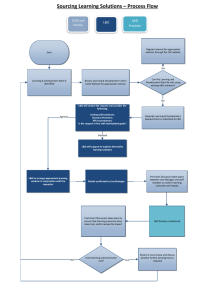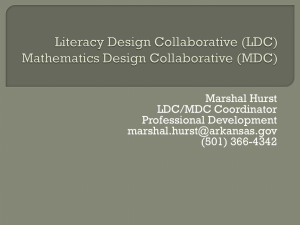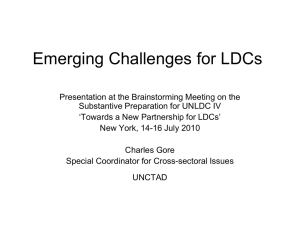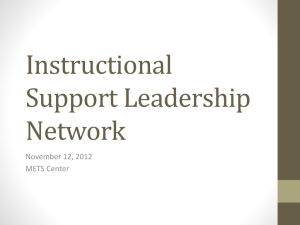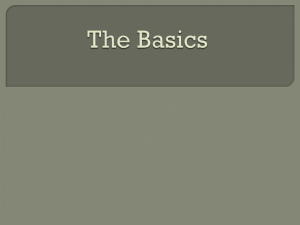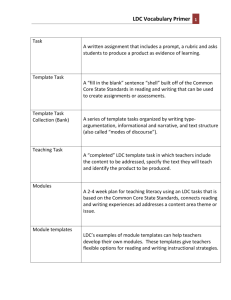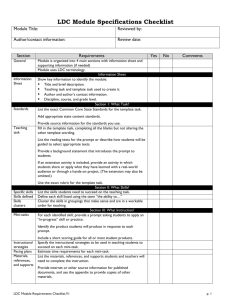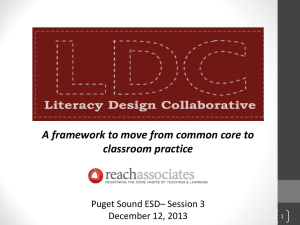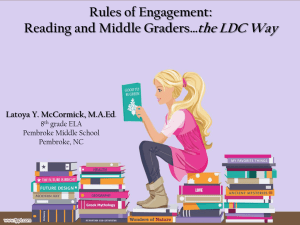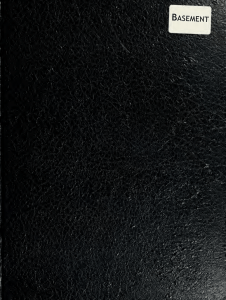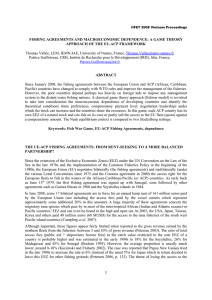LDC PPT. Oct. 18, 2013 new
advertisement
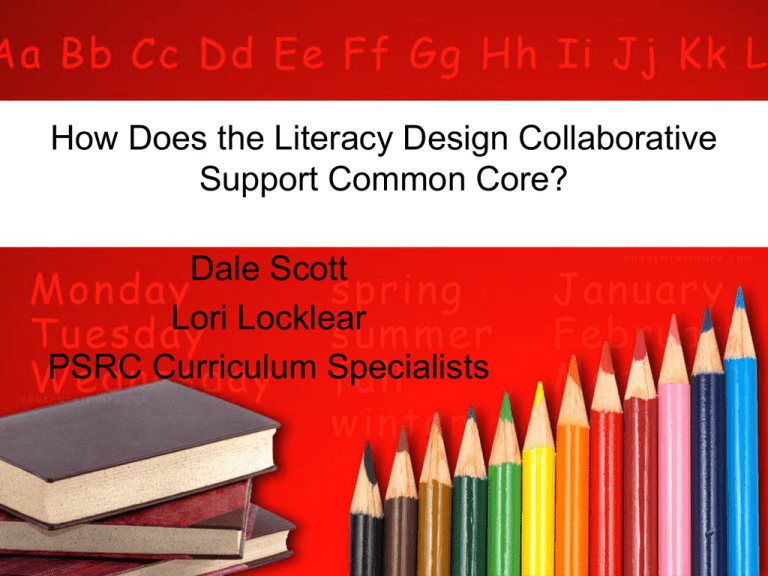
How Does the Literacy Design Collaborative Support Common Core? Dale Scott Lori Locklear PSRC Curriculum Specialists What is LDC? • The Literacy Design Collaborative is an initiative supported by the Bill and Melinda Gates Foundation • The Literacy Design collaborative was built upon Common Core Standards. • LDC merges CCSS literacy standards with important subject/content areas 3 Main Lenses…… Why LDC? • LDC work is centered around best practices in reading and writing instruction • All students are prepared for career or college • Differentiated Instruction (extended option) What should a CCSS/LDC classroom look like? • Learner-centered • Students working collaboratively • All classrooms use literacy as a tool for learning • Process more important than product • Shared decision making • Opportunities for innovation • Assessments take the form of observations conferences, daily work, writing, self-assessments • Integration of Curriculum Combatting Women’s Rights “Combating” Women’s Rights” ARGUMENTATIVE Description: While women’s rights are in a continual state of metamorphosis, women have continued “combating” the gender norms of society for centuries. American women, specifically, first publically denounced the treatment of their gender in Elizabeth Caddy Stanton’s “Declaration of Sentiments” that parodied the Declaration of Independence, and in turn, created a satirical masterpiece for ages to come. This masterpiece is a centerpiece of today’s most provocative question in women’s rights: Should women be allowed to fight in combat? Task 2: [Insert question] After reading ________ (literature or informational texts), write _____ (essay or substitute) that addresses the question and support your position with evidence from the text(s). L3 Give examples from past or current events or issues to illustrate and clarify your position. (Argumentation/Analysis) Should women be allowed to fight in combat? After reading primary and secondary sources pertaining to the history of women’s rights, as well as the pros and cons of women in the military, and specifically, in combat, write a speech for or against women’s right to fight in combat. Personal Influences • “Personal Influences” INFORMATIONAL Description: This module will show how individuals positively or negatively affect society. After reading the selected texts, students will analyze four speeches and an article to write an editorial. Template Task 21, L3 Task 21: [Insert question] After reading ________ (literature or informational texts), write a/an ________ (report, essay or substitutes) that addresses the question and analyzes ________ (content), providing examples to clarify your analysis. L3 Identify any gaps or unanswered questions. (Informational or Explanatory/Analysis) How can one individual make a difference? After reading Martin Luther King’s speech, “I Have a Dream”, Patrick Henry’s speech “Give Me Liberty or Give Me Death”, Time Magazine World article, “When Terror Loses Its Grip”, an excerpt from a speech given by Osama Bin Laden on October 30, 2004, and Marc Antony’s speech in Shakespeare’s Julius Caesar, write a guest editorial that addresses the question and analyzes the effects of positive and negative influences on society. 5 Strategies for Close Reading 1. Number the Paragraphs • CCSS requires citing and/or referring to the text. Numbering allows for easy reference. Number on the lefthand side. 2. Chunk the Text • Breaking up a text makes it more manageable for students. Draw lines if necessary. You can even group paragraphs or stanzas. Doesn’t matter how…just be able to justify why. (Intro. & Thesis, Pros, Cons., etc.) 5 Strategies for Close Reading 3. Underline and • Be Specific! Underline Circle with a “imagery” or “figurative Purpose language”. Circle “key terms”, “powerful verbs”, etc. 4. Left Margin • In 10 words or less, summarize what the author is SAYING. • Using a power verb (describing, illustrating, 5. Right Margin arguing, comparing, etc.), describe what the author is DOING. Transition Activity: Synthesis Synthesis Organizer: Bringing it all together In college, you will be expected to analyze a variety of individual resources both print (texts) and non-print (film); however, the analysis of these resources is just the beginning. The culminating ability for critical thinking is exhibited when you are able to synthesize--take those various resources and bring them back together in a product (paper, speech, PowerPoint, etc.), along with your interpretation of them into a single belief or philosophy that is supported through evidence. Directions Using the following Synthesis Chart, revisit each text, film, or news report we analyzed in class. Make note of any information through quotes or paraphrases that you might use to support your answer to the following task question: _________________________________________________________ _________________________________________________________ _________________________________________________________ Once you have collected this information, write a sentence/thesis answering the task question referring to the topic as well as stating your reason(s) for your claim/opinion/belief. Class Resources READINGS Quotes or Paraphrased Information and Page Number Resource #1 Title and Publication Information: Resource #2 Title and Publication Information: THESIS STATEMENT (W/LISTED POINTS OF REASONS WHY): ________________________________________________ ________________________________________________ ________________________________________________ ________________________________________________ ______________________________________________ Embedding Curriculum Maps into LDC Modules Curriculum Map Strand: Reading for Informational Text Domain: Key Ideas and Details Mathematical Practice(s): Construct viable Level of Thinking: Evaluate arguments and critique the reasoning of others. Anchor Standard: 1. Read closely to determine what the text says explicitly and to make logical inference from it; cite specific textual evidence when writing or speaking to support conclusions drawn from the text. Grade Specific Standard: RI.9-10.1. Cite strong and thorough textual evidence to support analysis of what the text says explicitly as well as inferences drawn from the text. Information Technology Standard: HS.TT.1.2 Use appropriate technology tools and other resources to organize information. Clarifying Objectives: Require students to reference text in order to support analysis and inferences from text. Task Analysis Vocabulary Time and Sequence Review: Recognize literary Cite Weeks: 1-3 terms related to Infer(ences) nonfiction. Analyze Weeks: 4-6 Identify textual Explicit evidence. Evidence Weeks: 7-9 Determine the Strong purpose of the text. Thorough Weeks:10-12 Examine author’s purpose within a text, Instruct: Weeks: 13-15 focusing on diction, Connotation syntax, denotation, Denotation Weeks: 15-18 connotation, bias, Syntax propaganda Voice techniques, theme, Oxymoron organization and Euphemism structure of the text. Bias Instructional Resources: Classroom Edition of the Wall Street Journal www.kellygallagher.org http://academics.keene.edu/tmendham/documents/AdlerMortimerHowToMarkABook_20060802.pdf http://www.criticalthinking.org/pages/critical-thinking-the-art-of-close-reading-part-one/509 Notes and Additional Information: LDC Impact on Student Learning and Accountability • LDC reflects the depth in rigor of the CCSS • Rigorous assignments prepare students for the “new” assessments • Students are challenged to think at higher levels (DOK)-Levels 2, 3 and 4 emphasis Training • SREB Consultants • In-House Training via Curriculum Specialists • Buddy Teachers • Ongoing County-wide Training (moved from High to Middle Schools) Buy-In to the LDC Approach • Common Core Correlated, specifically reading and writing standards • Administrator Value Questions
